Welcome to our comprehensive care guide for Echinodorus Helanthium Tenellus, also known as the dwarf or pygmy chain sword. If you’re a beginner looking to venture into the world of aquarium plants, you’ve come to the right place.
Echinodorus Helanthium Tenellus is an ideal choice for your freshwater tank. Its low-light requirements and ability to form a beautiful carpet make it popular among aquarists.
In this guide, we will provide you with detailed information on every aspect of Echinodorus Helanthium Tenellus care, from its origins and natural habitat to setting up the perfect environment in your aquarium.
We’ll cover lighting requirements, fertilization needs, propagation techniques, and even common challenges you may encounter in growing this stunning aquatic plant.
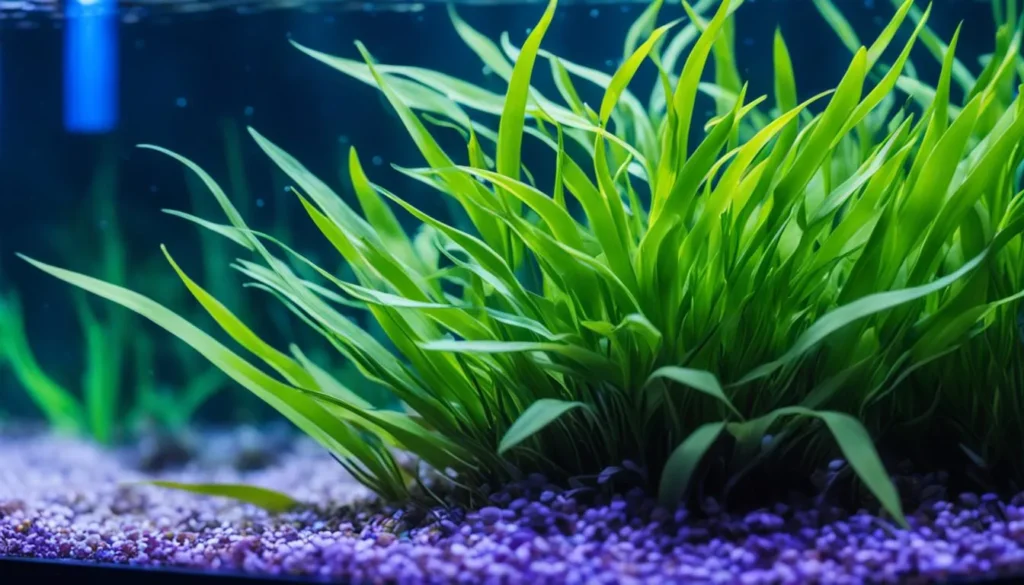
Key Takeaway
- Echinodorus Helanthium Tenellus is a beginner-friendly aquarium plant that creates a vibrant carpet in your tank.
- It is also known as the dwarf or pygmy chain sword and is a popular choice among aquarists.
- Echinodorus Helanthium Tenellus thrives in low-light conditions, making it a perfect choice for all types of aquarium setups.
- Proper substrate, water conditions, lighting, and fertilization are essential for the healthy growth of this plant.
- Regular maintenance, pruning, and propagation will ensure the long-term success of your Echinodorus Helanthium Tenellus carpet.
Quick Stats
| Attribute | Details |
| Family Name | Alismataceae |
| Origin | North and South America |
| Height | 5-10 cm (2-4 inches), can reach taller heights in less intense light |
| pH Range | 6.0 – 7.5 |
| CO2 Requirement | Low to Moderate |
| Growth Rate | Fast |
| Care Level | Easy to Moderate |
| Color Form | Green |
| Water Conditions | 22-28°C (72-82°F), adaptable to a wide range of hardness |
| Max Size | Leaves up to 10 cm (4 inches) long, with runners spreading wider |
| Lighting | Moderate to High |
| Supplements | CO2 beneficial for dense carpets; root tabs and liquid fertilizers support growth |
| Placement | Foreground |
| Propagation | By runners |
What Is Helanthium Tenellus?
Helanthium Tenellus, also known as the dwarf or pygmy chain sword, is a species of Echinodorus that is popular among aquarium enthusiasts. This aquatic plant is valued for its carpeting ability, making it an excellent choice for creating lush and vibrant underwater landscapes in aquariums.
Origins And Natural Habitat
- Helanthium Tenellus is native to the Amazon River basin in South America. In its natural habitat, it is found in marshes, ponds, streams, and other aquatic environments.
- This species has adapted to thrive in both submerged and partially submerged conditions, making it well-suited for aquarium cultivation.

Physical Characteristics
- One of the main features that sets Helanthium Tenellus apart is its narrow, grass-like leaves. These slender leaves grow from a central rosette and can reach heights of up to 12 inches.
- Growing densely creates a beautiful carpet effect that adds depth and visual interest to the aquarium. In addition to its aesthetic appeal, Helanthium Tenellus also provides hiding places for small fish and invertebrates.
Lighting Requirements For Healthy Growth
Adequate lighting is crucial for the healthy growth of Echinodorus Helanthium Tenellus. While it doesn’t require high-intensity lighting like some other carpeting plants, it thrives under medium-intensity lighting. Medium-intensity lighting promotes optimal photosynthesis and ensures proper growth. It’s important to note that bright lighting may cause the leaves of Echinodorus Helanthium Tenellus to develop a red tint, depending on the variety. This can add visual interest to your aquarium.
Temperature Needs Of Helanthium Tenellus
Helanthium tenellus thrives in tropical temperatures typically found in freshwater aquariums. The optimal temperature range for this plant is between 72°F to 82°F (22°C to 28°C).
Considerations
- Keep the aquarium temperature stable within this range to prevent stress to the plant.
- Avoid drastic temperature fluctuations, as they can negatively impact the growth and health of Helanthium tenellus.
- Ensure that the temperature is suitable for other inhabitants of the aquarium as well, as Helanthium tenellus is often kept with tropical fish species that have similar temperature requirements.
Optimal Water Temperature And pH
- In addition to the substrate, maintaining appropriate water conditions is vital for the well-being of Echinodorus Helanthium Tenellus. This plant thrives in slightly acidic water with a pH range of 6.2 to 7.5.
- Keeping the pH within this range ensures that the plant can effectively absorb nutrients for healthy growth and prevents any adverse effects on its overall health.
- Furthermore, maintaining the optimal water temperature is crucial. Echinodorus Helanthium Tenellus prefers normal freshwater tank temperatures between 68°F and 84°F. This temperature range provides an ideal plant growth environment and promotes optimal metabolic functions.
- Regular monitoring of water parameters and necessary adjustments, such as using additives or adjusting the temperature, are essential to maintaining stable and favorable conditions for Echinodorus Helanthium Tenellus.
| Water Parameter | Ideal Range |
| Water Temperature | 68°F – 84°F |
| pH Level | 6.2 – 7.5 |
Choosing The Right Substrate
- When selecting the substrate for your aquarium, choosing a suitable option for Echinodorus Helanthium Tenellus is important.
- This plant is a heavy root-feeder, absorbing nutrients primarily through its roots. Opt for a nutrient-rich aquarium substrate that provides essential elements for the plant’s growth and development.
- The ideal substrate should anchor the plant securely in the aquarium and allow for proper root growth. Consider using specialized substrates designed specifically for aquatic plants.
- These substrates are typically enriched with essential nutrients, including macro- and micronutrients, that promote healthy growth and vibrant colors in plants.
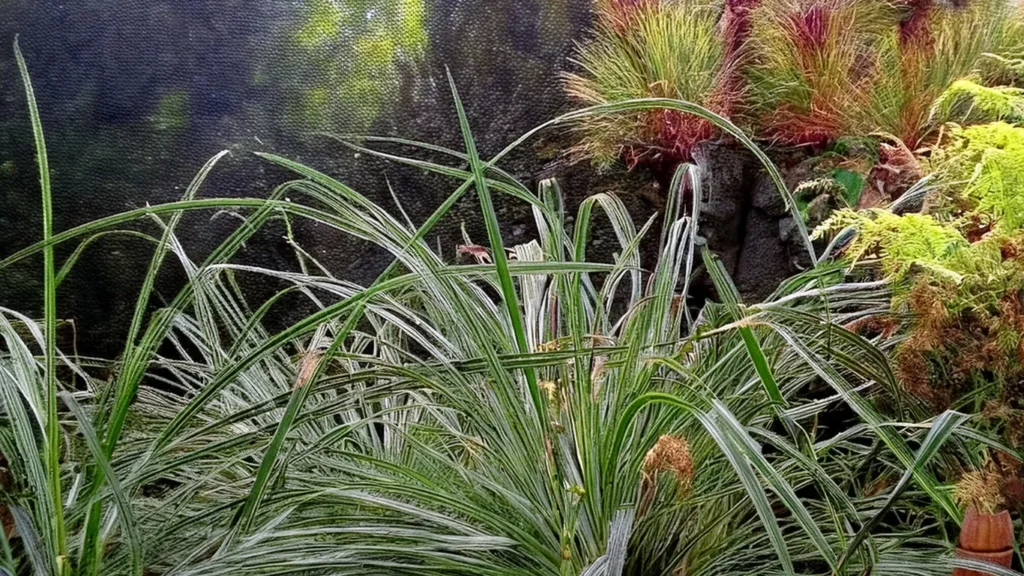
Recommended Tank Size
- For a small group or a few individual specimens of Helanthium tenellus, a tank size of at least 10 gallons (about 38 liters) can be suitable. This size allows enough space for the plants to spread and grow without overcrowding.
- If you plan to create a dense carpet of Helanthium tenellus or include a larger number of plants, you may want to consider a larger tank. A tank size of 20 gallons (about 75 liters) or more would provide ample space for a lush carpet to develop.
- Additionally, consider the overall layout and design of your aquarium. Helanthium tenellus is often used as a foreground or mid-ground plant, so ensure that there is sufficient space in the front or middle areas of the tank for planting.
- It’s also important to factor in the needs of other inhabitants of the aquarium, such as fish and invertebrates. Choose a tank size that accommodates the needs of all species and provides enough swimming and hiding space.
Suitable Tank mates
Small to Medium-sized Community Fish: Many peaceful community fish make excellent tank mates for Helanthium tenellus. Examples include:
- Tetras (such as neon tetras, cardinal tetras)
- Rasboras
- Guppies
- Mollies
- Platies
- Dwarf Gouramis
Bottom Dwellers: Species that inhabit the lower levels of the aquarium can coexist well with Helanthium tenellus. Consider adding:
- Corydoras catfish
- Dwarf corydoras
- Kuhli loaches
Shrimp and Snails: Many species of freshwater shrimp and snails make great tank mates for Helanthium tenellus and help clean up debris. Consider:
- Cherry shrimp
- Amano shrimp
- Nerite snails
- Malaysian trumpet snails
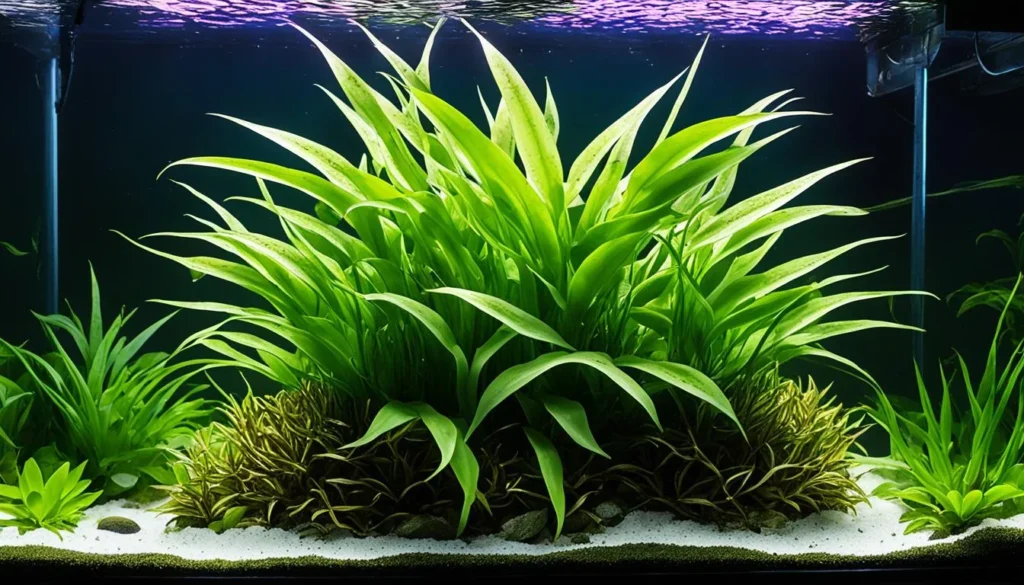
Placement Option In Tank
- Foreground Plant: Helanthium tenellus is often used as a foreground plant due to its relatively low height and spreading growth habit. Planting it in the front portion of the aquarium creates a lush carpet effect that adds depth and visual interest to the tank. Arrange the plants in a staggered pattern to achieve a natural look.
- Mid-Ground Plant: While Helanthium tenellus is typically considered a foreground plant, it can also be used effectively in the mid-ground area of the aquarium. Placing it in front of taller background plants or rock formations helps transition between the foreground and background, creating a cohesive aquascape.
- Border Plant: Use Helanthium tenellus to create a border along the edges of pathways or open areas in the aquarium. This can help define the space and create a neat, manicured appearance. Trim the plants regularly to maintain a tidy border.
RELATED: Grow Cryptocoryne Lutea For Vibrant Aquariums With This Simple Guide
Nutritional Requirement
Helanthium tenellus, like all aquarium plants, has specific nutritional requirements to support its growth and overall health. Understanding these requirements is crucial for maintaining thriving plants in your aquarium.
Macronutrients
- Nitrogen (N): Nitrogen is essential for protein synthesis and overall growth. It’s obtained primarily from ammonia, nitrite, and nitrate in the water column and substrate. Nitrogen deficiency can lead to stunted growth and yellowing leaves.
- Phosphorus (P): Phosphorus is crucial for energy transfer, cell division, and root development. It’s typically available in the form of phosphates in the water and substrate. Phosphorus deficiency can result in poor root growth and diminished overall health.
- Potassium (K): Potassium plays a vital role in enzyme activation, osmoregulation, and photosynthesis. It’s essential for maintaining turgor pressure and overall plant health. Potassium deficiency can cause leaf chlorosis and weakened cell walls.
Micronutrients
- Iron (Fe): Iron is necessary for chlorophyll synthesis and enzyme activation. It’s vital for photosynthesis and overall plant metabolism. Iron deficiency can result in yellowing leaves and poor growth.
- Magnesium (Mg): Magnesium is a component of chlorophyll and is essential for photosynthesis. It also plays a role in enzyme activation and nutrient uptake. Magnesium deficiency can cause interveinal chlorosis and poor growth.
- Calcium (Ca): Calcium is necessary for cell wall formation and structural integrity. It also regulates cell division and enzyme activity. Calcium deficiency can lead to distorted growth and weakened stems.

Cultivation Tips
- Choose Suitable Substrate: Helanthium tenellus benefits from a nutrient-rich substrate. Choose a substrate specifically designed for planted aquariums, such as aquasoil or nutrient-rich gravel. Alternatively, add root tabs or fertilizer pellets to provide essential nutrients directly to the plant’s roots.
- Provide Adequate Lighting: Helanthium tenellus thrives in moderate to high lighting conditions. Ensure your aquarium receives sufficient light for at least 8-10 hours a day. LED or fluorescent lights with a color temperature around 6500K are ideal for promoting plant growth.
- Maintain Stable Water Parameters: Helanthium tenellus prefers stable water parameters within the following ranges:
- Temperature: 72°F to 82°F (22°C to 28°C)
- pH: 6.5 to 7.5
- Hardness: Soft to moderately hard water (GH 4-15 dGH)
- Ammonia, nitrite, and nitrate levels should be kept low through regular water changes and proper filtration.Planting Technique: When planting Helanthium tenellus, carefully separate the individual plants and plant them into the substrate with tweezers or planting tongs. Space the plants a few inches apart to allow room for growth and propagation.
- Prune Regularly: Trim any dead, damaged, or yellowing leaves from Helanthium tenellus to promote healthy growth and prevent the spread of decay. Regular pruning encourages new growth and maintains the plant’s appearance.
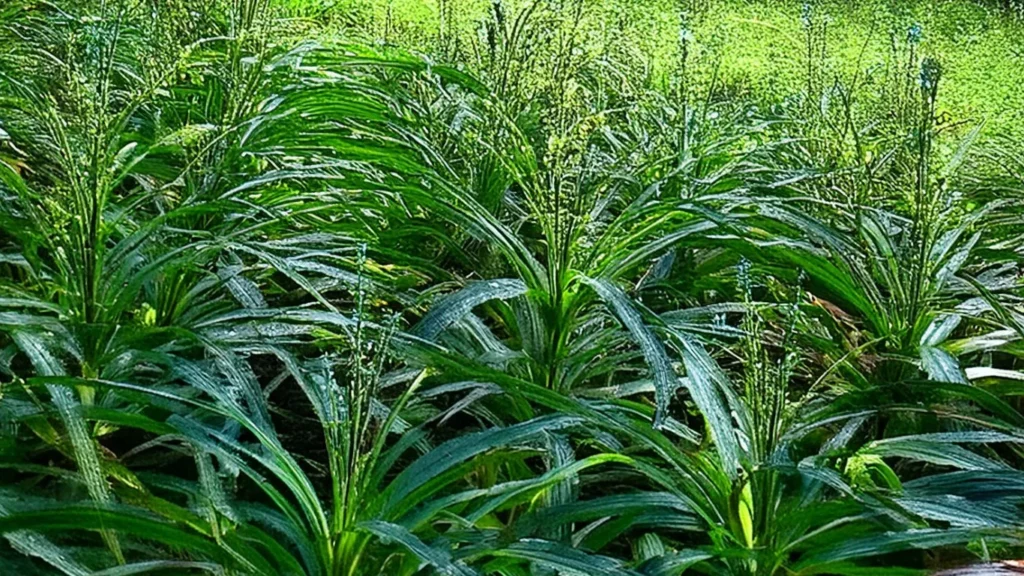
Plant Propagation Tips
- Identify healthy runners: Look for long, slender stems from the mother plant.
- Separate the plantlets: Gently separate them from the runners, ensuring they have formed roots.
- Prepare the growing medium: Plant the separated plantlets in a nutrient-rich growing medium, such as an aquarium substrate or a mixture of nutrient-rich soil and sand.
- Provide optimal conditions: Place the newly planted plantlets in an aquarium with suitable water, lighting, and temperature conditions.
- Maintain regular pruning: Regularly prune the plant to maintain a dense and well-groomed carpet.
Benefits Of Planting Helanthium Tenellus
- Natural Aesthetic: Helanthium tenellus forms dense carpets of vibrant green foliage that add a natural and lush appearance to your aquarium. Its low-growing habit creates a beautiful foreground or mid-ground carpet that enhances the overall aesthetic appeal of the tank.
- Oxygenation: Like all aquatic plants, Helanthium tenellus contributes to oxygenation of the aquarium water through photosynthesis. During photosynthesis, plants absorb carbon dioxide and release oxygen, helping to maintain optimal oxygen levels for fish and other aquatic inhabitants.
- Water Filtration: Helanthium tenellus helps improve water quality by absorbing nutrients such as nitrates, ammonia, and phosphates from the water column. By reducing excess nutrients, it helps inhibit algae growth and creates a healthier aquatic environment for your fish and other aquatic life.
- Habitat and Refuge: Helanthium tenellus provides shelter and refuge for small fish, shrimp, and other aquatic organisms. Its dense carpeting creates hiding places for shy or vulnerable species, helping to reduce stress and promote natural behavior.
- Prevents Soil Erosion: The root system of Helanthium tenellus helps anchor the substrate, preventing soil erosion and maintaining the stability of the aquarium environment. This is particularly beneficial in tanks with active fish species or strong water flow.
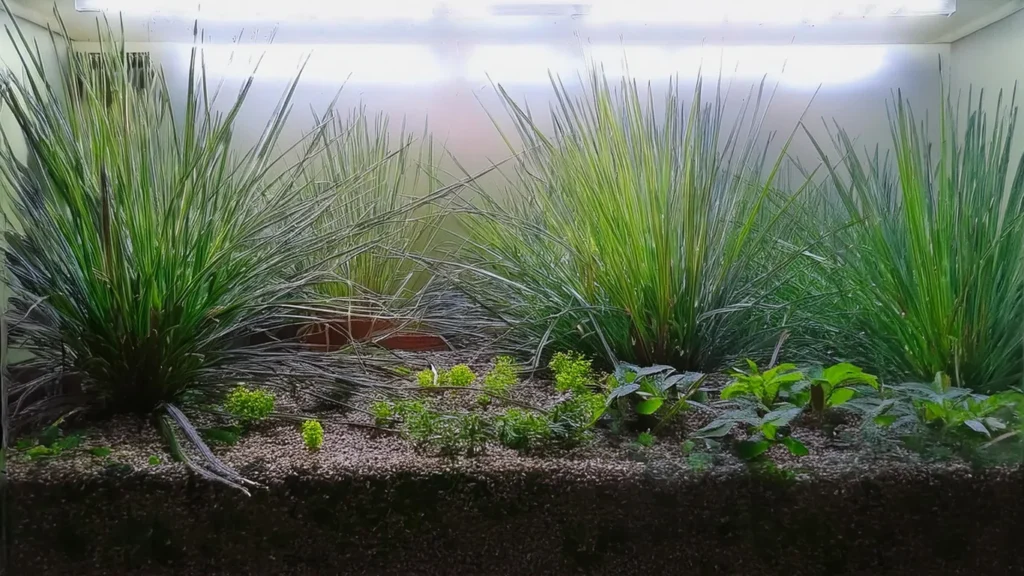
Dealing With Common Pests And Diseases
- Pests and diseases can threaten the growth and health of Echinodorus Helanthium Tenellus. Snails, in particular, can quickly multiply and damage the plant if not properly controlled.
- Regularly inspect the plant; if any pests are found, they should be manually removed or treated with a suitable aquarium-safe pest control product. Diseases such as fungus or bacterial infections can also occur.
- If any signs of disease are noticed, it is important to promptly address the issue by removing affected leaves or using appropriate treatments prescribed by experts or professionals.
Benefits Of Adding Echinodorus Helanthium Tenellus To Your Aquarium
- Adding Echinodorus Helanthium Tenellus to your aquarium offers several benefits. First, it enhances the tank’s overall aesthetic appeal, creating a natural and visually pleasing landscape.
- The carpeting effect created by the densely growing leaves adds depth and dimension to the aquarium, mimicking the look of natural aquatic habitats.
- Helanthium Tenellus also helps oxygenate the water and contributes to a healthy aquatic environment for fish and invertebrates.
- Its dense growth also provides a natural hiding place for shy or small fish, creating a more secure and comfortable habitat for them.
RELATED: The Aquatic Wonder Bacopa Australis To Transform Your Aquascape
Conclusion
Echinodorus Helanthium Tenellus is the perfect carpeting plant for beginners looking to enhance the beauty of their aquarium. Its ease of care and versatile growth capabilities make it an ideal choice.
You can create a vibrant and lush carpet that will transform your aquarium into a stunning underwater landscape by providing the right substrate, water conditions, lighting, and fertilization.
Regular maintenance, pruning, and propagation are essential to ensure the continued health and success of your Echinodorus Helanthium Tenellus carpet. You can maintain a dense and uniform growth pattern by trimming tall and excess leaves.
Managing runners will prevent them from intertwining and keep your carpet looking neat and tidy.
Feel free to experiment with different varieties of Echinodorus Helanthium Tenellus to add unique elements to your aquascape. Whether you choose the ‘Broadleaf’ variety with its broader leaves or the ‘Red’ variety known for its reddish coloration, these options provide endless possibilities for creating a visually captivating aquarium.
Frequently Asked Questions
How Can I Accelerate The Carpeting Effect Of Echinodorus Helanthium ‘tenellus’ In My Aquarium?
Accelerating the carpeting effect requires a combination of high lighting, CO2 supplementation, and a nutrient-rich substrate. High lighting promotes dense growth and encourages the plant to spread horizontally. CO2 supplementation boosts growth speed and overall plant health.
Finally, a substrate rich in nutrients, especially iron, supports root development and vibrant growth. Regular trimming also encourages the plant to spread out and grow more densely.
What Specific Nutrient Deficiencies Most Commonly Affect Echinodorus Helanthium ‘tenellus,’ And How Can They Be Identified And Corrected?
Echinodorus helanthium ‘Tenellus’ is particularly susceptible to iron and potassium deficiencies. Iron deficiency is indicated by yellowing of new leaves, while potassium deficiency often shows as pinholes or yellowing in older leaves.
Use specific iron and potassium supplements according to the product instructions to correct these deficiencies. Regular substrate fertilization and liquid dosing can prevent future deficiencies.
Can Echinodorus Helanthium ‘tenellus’ Be Grown Emersed, And If So, What Conditions Are Required?
Yes, Echinodorus helanthium ‘Tenellus’ can be grown emersed and often does quite well in such conditions. To grow it, it emerged, maintained high humidity (above 75%), provided strong lighting, and kept the substrate consistently moist but not waterlogged.
Emersed cultivation can lead to faster growth and is an excellent way to propagate the plant as it produces flowers and seeds more readily above water.
How Does Water Hardness Affect The Growth Of Echinodorus Helanthium ‘tenellus’, And How Can Water Conditions Be Optimized?
Echinodorus helanthium ‘Tenellus’ prefers soft to moderately hard water, with a 2-12 dGH hardness range. Hard water can inhibit growth by making it difficult for the plant to absorb certain nutrients.
If your water is naturally hard, use reverse osmosis water mixed with tap water to achieve the desired hardness. Adding CO2 can also lower the pH and slightly soften the water, creating more favorable conditions for growth.
What Advanced Techniques Can Be Used To Manage Algae Growth On Echinodorus Helanthium ‘tenellus’ Without Harming The Plant?
Managing algae on Echinodorus helanthium ‘Tenellus’ involves optimizing tank conditions to favor the plant over algae. Ensure balanced lighting (not too intense or too prolonged) and keep nutrient levels in check to avoid feeding the algae.
Introducing algae-eating fish or invertebrates can help control algae growth naturally. For persistent algae, spot treatments with diluted hydrogen peroxide (H2O2) can be effective; apply it carefully using a syringe directly to the affected areas during a water change to minimize the impact on the plant.
- Unveiling The Wonders Of Riccia Fluitans In Aquascapes - August 7, 2024
- Vallisneria Gigantea Var. Guide To Care And Cultivation At Home - July 31, 2024
- Vesicularia Dubyana Care & Growth Guide Tips For Beginner Gardeners - July 30, 2024
